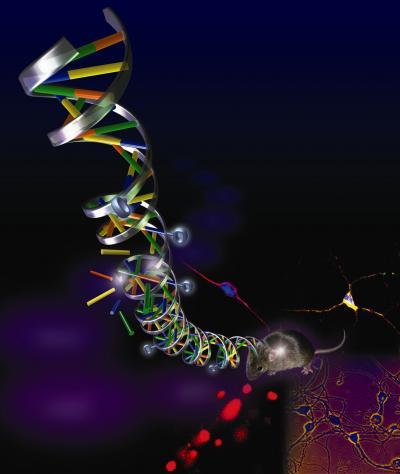Huntington’s disease, an inherited neurodegenerative disorder that affects roughly 30,000 Americans, is incurable and fatal. But a new discovery about how cells repair their DNA points to a possible way to stop or slow the onset of the disease. The research was funded by the National Institutes of Health (NIH).
"As so often happens, basic research on a fundamental biological process—in this case, enzymes involved in DNA repair—leads to new insights about how diseases arise and new approaches for treating or preventing them," said NIH Director Elias A. Zerhouni, M.D. Artistic rendering of a broken DNA helix emanating from a mouse nerve cell. Researchers recently uncovered evidence that faulty DNA repair may be to blame for the onset of Huntington's disease symptoms. Credit: Cynthia McMurray
Artistic rendering of a broken DNA helix emanating from a mouse nerve cell. Researchers recently uncovered evidence that faulty DNA repair may be to blame for the onset of Huntington's disease symptoms. Credit: Cynthia McMurray
The study was published April 22 as an Advanced Online Publication in Nature and led by Cynthia T. McMurray, Ph.D., a professor of pharmacology at the Mayo Clinic in Rochester, Minnesota.
Unlike most inherited diseases, Huntington’s disease symptoms usually don’t appear until middle age, leading scientists to wonder what triggers the disease onset and whether it can be halted—or at least slowed down.
People with the disease have a version of a gene called huntingtin that carries an extra segment with a particular sequence of repeated subunits. If the segment is too large, the gene produces a faulty protein that has a destructive effect in the brain.
"Huntington’s disease is a progressive disease, but nobody knows exactly why," said McMurray. "Our work supports the idea that the disease progresses when the extra segment expands over time in non-dividing cells such as nerve cells."
McMurray’s study shows that the inserted segment grows when cells try to remove oxidative lesions, which are caused by byproducts of the oxygen we breathe. DNA repair enzymes initially keep oxidative lesions in check, but over time, increasing numbers of lesions overwhelm the repair systems. Oxidative lesions also accumulate in people who do not have Huntington’s disease, but because their huntingtin gene lacks the extra segment it is not prone to expansion.
While scientists have long suspected that oxidative lesions play a role in Huntington’s disease, the specific role of the lesions has remained elusive until now.
"Nobody has connected the dots before," said McMurray.
To show that the extra segment enlarges with age, the researchers engineered mice to carry a version of the human huntingtin gene with an inserted segment—one large enough to cause Huntington’s disease in humans. After a few months—when the mice had aged—the scientists analyzed the gene and found that the segment had expanded. They also observed an increase in oxidative lesions in the mouse DNA.
To see if the oxidative lesions played a role in expansion of the extra DNA segment, the researchers next deleted OGG1, a key enzyme in oxidative lesion repair. Without OGG1, the bulk of the DNA’s oxidative lesions remained untouched, and the inserted segment did not grow at all or it grew far less than in mice carrying a working version of OGG1.
These findings show that while doing its part in removing oxidative lesions, OGG1 triggers a far more damaging effect—the DNA expansion associated with Huntington’s disease.
"The effect is much like what might happen if a technician came to repair a minor defect in your computer but was called away by a more urgent problem midway through the process. Now your computer is lying in pieces and you’re unable to use it," said McMurray.
The study suggests that OGG1 might offer a target for the development of new Huntington’s disease treatments. McMurray’s team is already pursuing this path and is screening for small molecules that block OGG1 function. This work may also be relevant to research on other diseases, such as Alzheimer’s and Parkinson’s, in which oxidative lesions are believed to play a role.